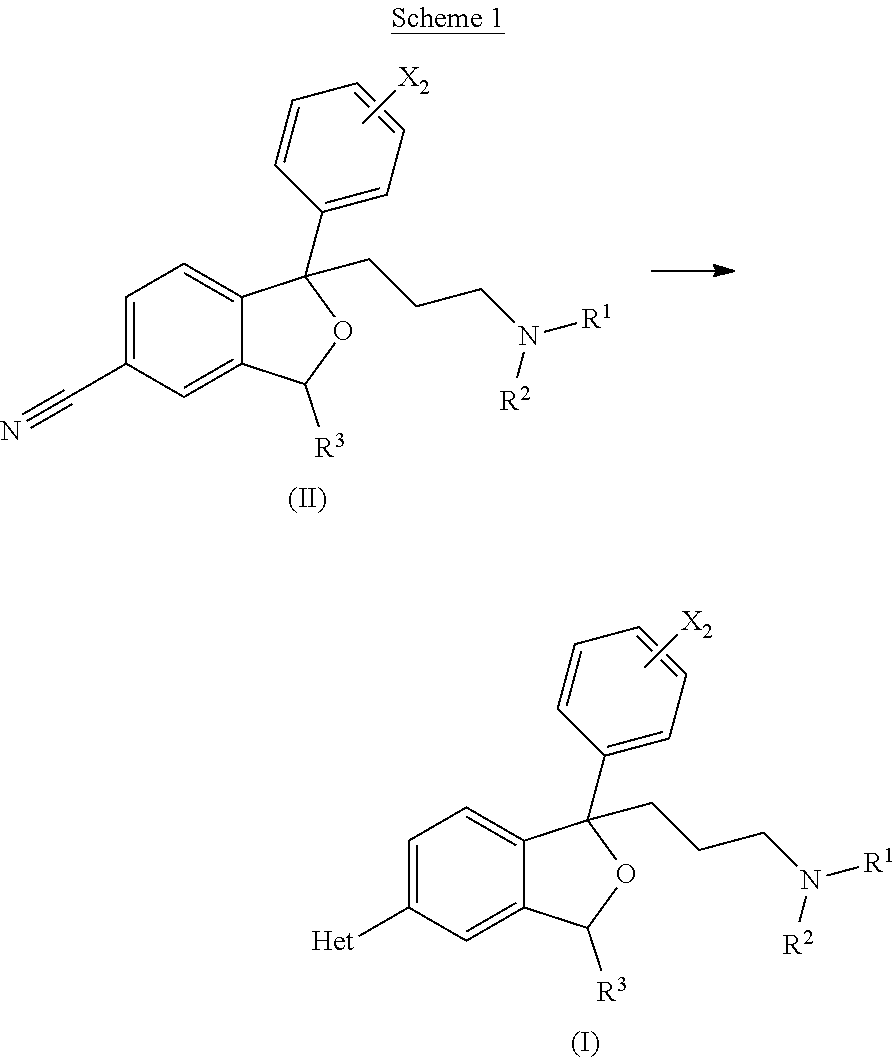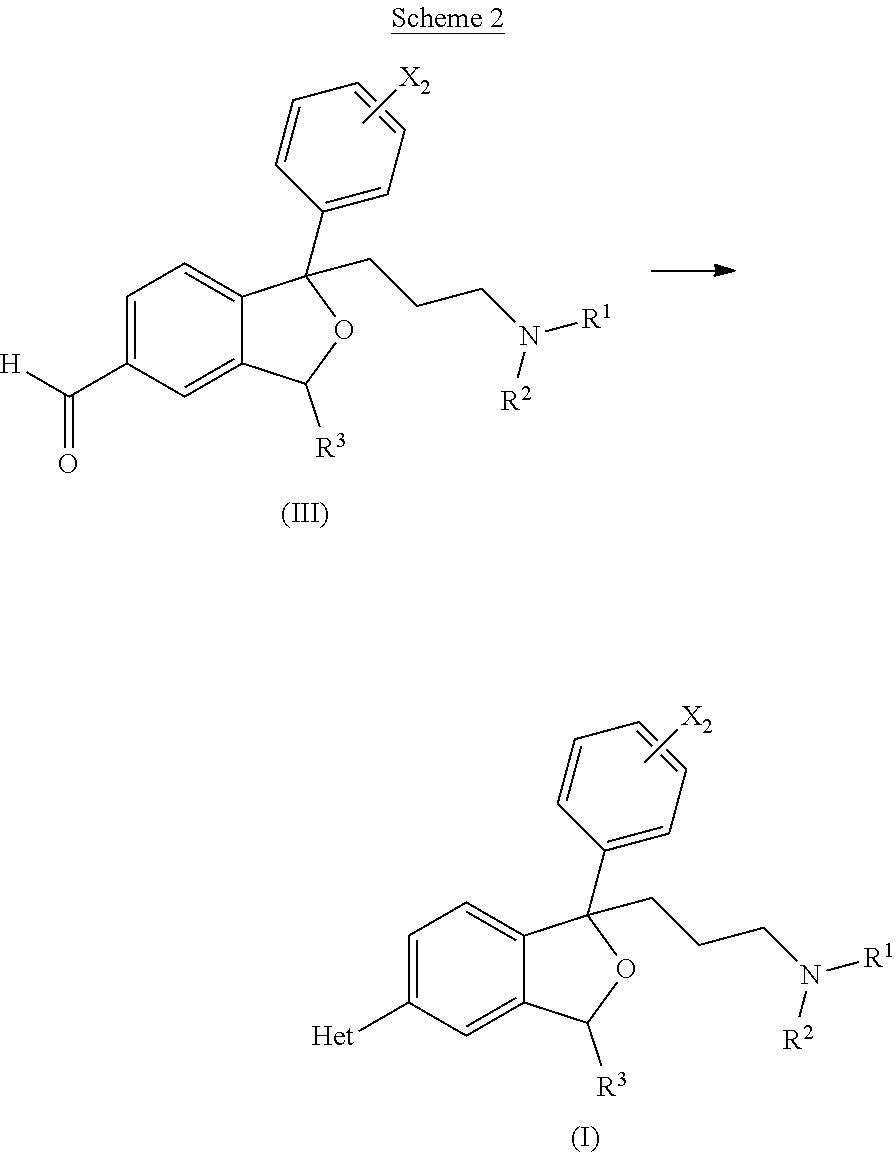Bicyclic Antiparasitic Compounds
a bicyclic antiparasitic and compound technology, applied in the field of compounds, can solve the problems of poor penetration of the blood-brain barrier, rapid rebound of cases, and limited use of some of these drugs
- Summary
- Abstract
- Description
- Claims
- Application Information
AI Technical Summary
Benefits of technology
Problems solved by technology
Method used
Image
Examples
example 1
[0174]
3-[1-(4-fluorophenyl)-5-(1H-indol-4-yl)-1,3-dihydro-2-benzofuran-1-yl]-N,N-di-methylpropan-1-amine
[0175]250 mg (0.66 mmol, MW=378) of 3-[5-bromo-1-(4-fluorophenyl)-1,3-dihydro-2-benzofuran-1-yl]-N,N-dimethylpropan-1-amine (IV, the title compound of Preparation 1) and 38 mg (0.033 mmol, MW=1156) of tetrakis-triphenylphosphine palladium(0) in 4.0 mL of dioxane was stirred at room temperature for 30 min. Next, 322 mg (1.32 mmol, MW=243, Sigma-Aldrich, St. Louis, Mo.) of 5-indolylboronic acid pinacol ester and 350 mg (23.2 mmol, MW=106) of Na2CO3 were added, followed by 1.0 mL of water. The reactants were stirred at 80-85° C. under N2 for 4 hr, during which time the solution color changed from yellow to near black.
[0176]The reaction was worked up by separating the organic layer, washing it with water and then with saturated aqueous NaCl. The organic layer was next dried over MgSO4, treated with darco and filtered through diatomaceous earth (d.e.). The solvent was removed in vacuo ...
example 2
[0180]
3-[1-(4-fluorophenyl)-5-(1,3-benzoxazol-5-yl)-1,3-dihydro-2-benzofuran-1-yl]-N,N-dimethylpropan-1-amine
[0181]In the same manner as Example 1, 175 mg (0.463 mmol, MW=378) of IV (Prep 1) in 4.0 mL dioxane was treated with 26 mg (0.0225 mmol, MW=1156) of (PPh3)4Pd(0) at room temp for 30 min, followed by the addition of 227 mg (0.926 mmol, MW=245.1; Combi-Blocks, INC., San Diego, Calif., USA) of 1,3-benzoxazole-5-boronic acid pinacol ester and 245 mg (2.31 mmol, MW=106) of Na2CO3 with 1.0 mL H2O. After heating at 80-85° C. under N2 for 4 hr, the dark red solution was extracted in a separatory funnel with ethyl acetate. The organic layer was washed with H2O and saturated NaCl, dried over MgSO4 and treated with Darco (activated charcoal). After filtration through a pad of diatomaceous earth (d.e.), the solvent was removed in vacuo to produce a crude oil.
[0182]The oil was chromatographed on a silica gel plate (2000 micron thickness, Analtech) and eluted with 90 EtOAc: 10 AcCN: 0.5 mL...
example 3
[0186]
3-[1-(4-fluorophenyl)-5-(1,3-benzothiazol-5-yl)-1,3-dihydro-2-benzofuran-1-yl]-N,N-dimethylpropan-1-amine
[0187]In the same manner as Example 1, 250 mg (0.66 mmol, MW=378) of IV in 4.0 mL dioxane was treated with 38 mg (0.033 mmol, MW=1156) of (PPh3)4Pd(0) at room temp for 30 min, followed by the addition of 345 mg (1.32 mmol, MW=261.1; Combi-Blocks, INC., San Diego, Calif., USA) of benzothiazole-5-boronic acid pinacol ester and 350 mg (3.3 mmol, MW=106) of Na2CO3 with 1.0 mL H2O. After heating at 80-85° C. under N2 for 4 hr, the dark red solution was extracted with EtOAc in a separatory funnel. The organic layer was washed with H2O and saturated NaCl, dried over MgSO4 and treated with Darco (activated charcoal). After filtration through a pad of d.e., the solvent was removed in vacuo to produce a crude oil.
[0188]The oil was chromatographed on a silica gel plate (2000 micron, Analtech) and eluted with 90 EtOAc: 10 AcCN: 0.5 mL TEA. The silica gel band containing the product was...
PUM
| Property | Measurement | Unit |
|---|---|---|
| thick | aaaaa | aaaaa |
| thick | aaaaa | aaaaa |
| thick | aaaaa | aaaaa |
Abstract
Description
Claims
Application Information
 Login to View More
Login to View More - R&D
- Intellectual Property
- Life Sciences
- Materials
- Tech Scout
- Unparalleled Data Quality
- Higher Quality Content
- 60% Fewer Hallucinations
Browse by: Latest US Patents, China's latest patents, Technical Efficacy Thesaurus, Application Domain, Technology Topic, Popular Technical Reports.
© 2025 PatSnap. All rights reserved.Legal|Privacy policy|Modern Slavery Act Transparency Statement|Sitemap|About US| Contact US: help@patsnap.com



